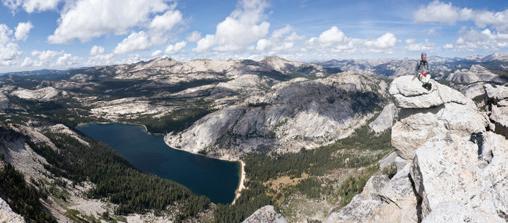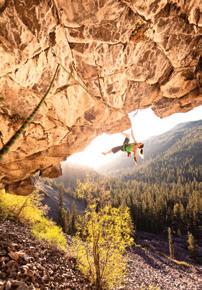
3 minute read
ONE MORE TIME
By the time I finally slogged my way up the last bit of talus; Julia had harnessed up and traversed the base of the cliff. She flaked her rope beneath a potential warm-up and ate some of her sandwich as I awkwardly bounced up and down on one leg, trying to stuff my foot through a twisted loop in my harness. I didn’t even bother to look up at the “warmup.” Everything at Columns of the Giants is at least 5.12a and I didn’t feel like attempting anything. My only goal for the day was to shoot a sunset photo of Julia on Delirious (5.12a).
I managed the rope as she lapped a few “moderate” 5.12 routes. In between belay duty I’d gaze backwards up the imposing overhanging wall and over towards Delirious, wondering how the hell I was going to get a photo of Julia from the vantage point that I wanted, mid-way up the cliff, and belay her on the route at the same time. As the sun fell lower towards the west slope of the Sierra, Julia tried a few harder climbs. Finally, we pulled the rope and started to get ready to make the photograph.
Advertisement
Reaching into my pack I pulled out a heavy bag containing a few lenses and the professional Canon camera that Julia had selflessly given to me on my birthday a few years prior. “Since you’re taking pretty good pictures with that shitty old camera, I figured you should probably have something that works half the time,” she’d said.
I slung the camera over my shoulder and then scratched and scraped my way up the first vertical section of the route. Grabbing quickdraws, cursing and thrashing, I finally hauled myself up to the third bolt. I was able to swing to the left, clip a bolt on an adjacent route, and then equalize that bolt with the third lead bolt on Delirious to make a really huge and weird looking “anchor.” The plan was to climb the route in two miniature pitches. This way, as Julia climbed toward the lip of the impressive roof, I would be at a makeshift hanging belay at eye-level with her, belaying as the top priority, but with the camera ready to take some pictures when it felt safe. It was destined to be an all-out shit-show and I was glad there were no other climbers at the cliff to make fun of me as I squirmed around at the ridiculous looking hanging belay.
As the sun dipped slowly beyond the Sierra foothills to the west, Julia calmly and slowly made her way out the imposing roof feature, her legs dangling free in space as she swung gracefully from one gigantic hold to the next. As she gained the lip of the roof and clipped the last bolt, the sun moved just low enough to illuminate the massive cave feature behind her. “Do you feel safe there?” I asked. “Totally,” she said, practically whispering the words as she hung almost completely upside down. I tied a back-up knot below my Gri-Gri, slung my camera forward, and made the photograph.

EDITOR’S NOTE
As an art form, climbing photography is separated from landscape photography by a single element: the subject. The subject [or climber] can be as miniscule as a spot of color or shape on a far away boulder or cliff, or close to the lens, consuming the entire frame with action and expression. As enamored as we are with California’s vast and beautiful spaces, the exposure, the rocks and crags and cliffs and boulders, it is the subject of these photos that connects us and allows us to imagine ourselves interacting with these magnificent settings. A truly great climbing photograph is a thing of magic; a moment when the camera captures the marrying of subject and setting.

A good “subject” can be a person who knows how to rock climb and is willing to let you photograph them in a bright T-shirt, but to make consistently great climbing photographs, you need a great partner; a person who believes in your work as much, or more, than you do. Someone who is willing to wait while you take forever to haul up your camera gear, then flail and flap and spin in space, and botch the focus, and then oblige you when you ask them to do the move “one more time,” twenty more times. To the viewer, climbing photographs on printed pages represent an exciting experience in a beautiful setting, but to the photographers and subjects, these photographs represent a moment of vulnerability frozen in time between partners.
“Climbing is often an immensely personal experience, and I am grateful for those who let me share those experiences with them,” says Victoria Kohner-Flanagan in this issue’s Behind the Lens feature. “The photos themselves provide a sense of permanence to these otherwise fleeting moments,” adds Kohner-Flanagan, “I hope to cement moments that call attention to things we often lose sight of: extraordinary spaces, imposing and exciting challenges, and the people we get to share those things with.” In this edition of California Climber we’re proud to feature 12 pages of Kohner-Flanagan's recent photographic experiences; some of her best work yet. For more, check out this issue’s Behind the Lens on page 24.
—DEAN FLEMING






